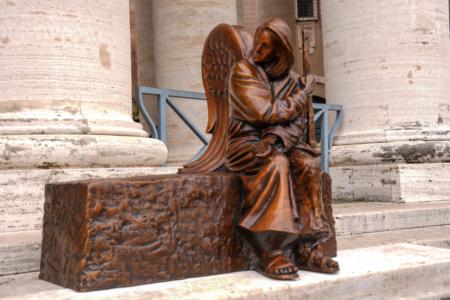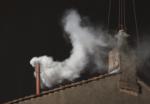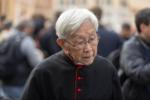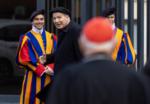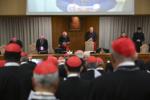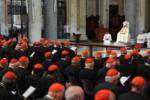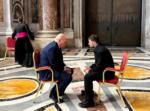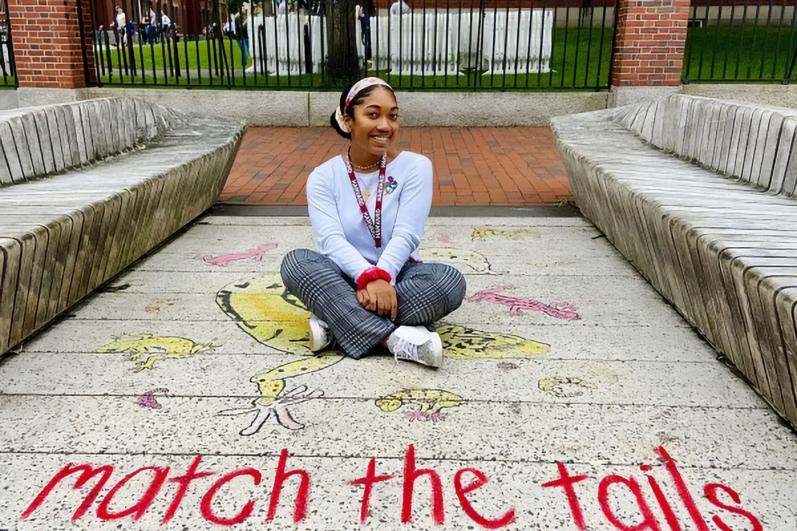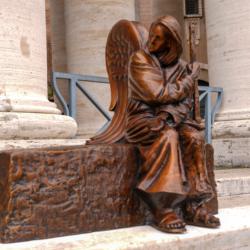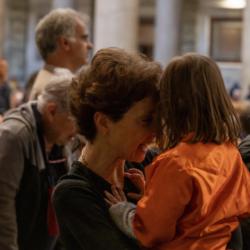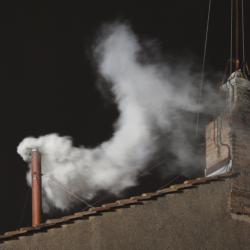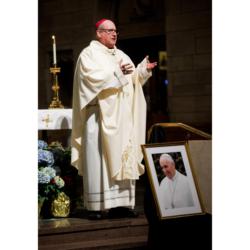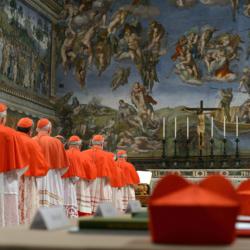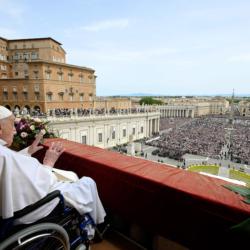Finding faith at Harvard: Easter conversion stories to make your day
CAMBRIDGE (CAN) -- One convert's journey to Catholicism began with an invitation to an ice-cream social.
Another says he instantly believed in the Real Presence the moment someone explained what the round object was that everyone was staring at during eucharistic adoration.
For a third, the poems of T.S. Eliot -- and a seemingly random encounter with a priest on a public street -- led to deeper questions about truth and faith.
Their paths differed but led them to the same destination: St. Paul's Catholic Church in Cambridge, where they are among 31 people set to be fully initiated into the Catholic Church during the Easter Vigil Mass on April 16.
That number of initiates is a record high for St. Paul's, a nearly century-old Romanesque-style brick church whose bell tower looms over Harvard Square.
A scheduling backlog caused by the COVID-19 pandemic is partly responsible for the size of this year's group of catechumens (non-baptized) and candidates (baptized non-Catholics.) But Father Patrick J. Fiorillo, the parochial vicar at St. Paul's, believes there's more to it than that.
"There's definitely a significant segment of people who started thinking more deeply about their lives and faith during COVID-19," Fiorillo said. "So, coming out of Covid has given them the occasion to take the next step and move forward."
Fiorillo is the undergraduate chaplain for the Harvard Catholic Center, a chaplaincy based at St. Paul's for undergraduate and graduate students at Harvard University and other academic institutions in the area. This year, 17 of the 31 initiates are Harvard students.
"Everybody assumes that, because this is the Harvard Catholic Center, that everybody here is very smart and therefore has a very highly intellectual orientation towards their faith," Fiorillo told CAN.
"That is definitely true of some people. But I would say the majority are not here because of intellectually thinking their way into the faith. Some are. But the majority are just kind of ordinary life circumstances, just seeking, questioning the ways of the world, and just trying to get in touch with this desire on their heart for something more," he said.
Fiorillo says welcoming converts into the Church at the Easter vigil is one of the highlights of his ministry.
"It's an honor. It gives me hope just seeing all this new life and new faith here. So much in one place," he said.
"When I tell other people about it, it gives them hope to hear that many young people are still converting to Catholicism, and they're doing it in a place as secular as Cambridge."
'This is what I've been looking for'
Katie Cabrera, a 19-year-old Harvard freshman, told CAN that she was excited to experience the "transformative power of Christ through his body and blood" at Mass for the first time at the Easter vigil.
A native of Dorchester, Massachusetts, she said she was baptized as a child and comes from a family of Dominican immigrants. Her father, who grew up in an extremely impoverished area, lacked a formal education, but always kept the traditions of the Catholic faith close to him in order to persevere in difficult times.
Her father's love for her and his Catholic faith deeply inspired Cabrera, and served as an anchor for her faith throughout her life.
Growing up, however, Cabrera attended a non-denominational church with her mother. Because she felt the church's teachings lacked an emphasis on God's love and mercy, Cabrera eventually left.
"Even though I Ieft, I always knew that I believed in God," Cabrera said. "So, I was at a place where I felt kind of lost, because I always had that faith, but I didn't know what to do with it."
After she arrived at Harvard, she accepted a friend's invitation to attend an ice-cream social at the Harvard Catholic Center -- "and that was like, sort of, how it all started," she told CAN.
Once she was added to the email list for the center's events, she felt a "calling" that she "really wanted to officially become Catholic" after many difficult years without a faith community.
Catholic doctrine about the sacraments was no hurdle for Cabrera, as she credits Fiorillo with explaining the faith well.
'What's the Eucharist?'
"What is that thing on the thing?"
Kent Shi laughs when he recalls how perplexed he was the first time he attended eucharistic adoration at St. Mary's of the Assumption in Cambridge.
Someone helpfully explained that what Shi was looking at was the Eucharist displayed inside a monstrance.
"What's the Eucharist?" he wanted to know.
For many non-Catholics considering entering the Catholic Church, the Real Presence can be a major obstacle.
Not Shi. He says that once the Eucharist was explained to him that day, he instantly believed.
Shi, 25, told CAN that he considered himself an agnostic for most of his life, meaning he neither believed nor disbelieved in God.
Between his first and second years as a graduate student in Harvard's Kennedy School of Government, however, he accepted Christ and started attending services at a Presbyterian church.
One day in the summer of 2021, a crucifix outside St. Paul's that Shi says he "must have passed multiple times a week for months and never noticed" caught his eye, and deeply moved him.
Shortly after, he accepted a friend's invitation to attend eucharistic adoration at St. Mary's even though he "didn't know what adoration meant." Unaware of what he was about to walk into, Shi asked a friend what the dress code was for adoration. His friend replied, "Respectful."
And so, respectfully dressed in a button-down shirt and slacks, Shi sat in the front row with his friend, only a few feet from the monstrance. That's when the questions began.
It wasn't long after that encounter that Shi began attending Mass at St. Paul's and the parish's RCIA (Rite of Christian Initiation for Adults) program. Shi asked CAN readers to pray for him and his fellow RCIA classmates.
"There's a lot of prodigal sons and daughters here, so we would very much appreciate that," he said, "especially me."
Poetry and art opened the door
For Loren Brown, choosing to attend a secular university like Harvard proved to be "providential."
The 25-year-old junior from La Center, Washington, said he comes from a "lapsed" Catholic family and wasn't baptized.
He didn't think much about the faith until the spring semester of his freshman year, when, he says, Catholic friends of his "began to question my lack of commitment to faith."
Later, when students were sent home to take classes virtually due to the pandemic, he had time to reflect and began to read some of the books they'd recommended to him. The poetry of T.S. Eliot (his favorite set of poems being "Four Quartets") and the "Confessions" by St. Augustine, in particular, "pulled me towards the faith," he said.
Brown describes his conversion as a "gradual process" which backed him into a "logical corner." But a chance meeting with a priest also played a pivotal role.
One day in the summer of 2021 while walking back to his dormitory he encountered a man wearing a priestly collar outside St. Paul's Church on busy Mount Auburn Street.
It was Father George Salzmann, graduate chaplain of the Harvard Catholic Center.
"He asked me how I was doing, what I was studying, and we immediately found a common interest in St. Augustine," Brown told CAN.
"You know, there's this great window of St. Augustine inside St. Paul's and you should come see it," Brown remembers the gregarious priest telling him. Salzmann wound up giving Brown a brief tour of the church, which was completed in 1923.
The next week, Brown found himself sitting in a pew for his first Sunday Mass at St. Paul's. He hasn't missed a Sunday since, a routine that ultimately led him to join the RCIA program that fall.
Brown says he now realizes that coming to Harvard was about more than majoring in education.
"What I wanted out of Harvard has completely changed," he said. "Instead of an education that prepares me for a job or a career, I want one that forms me as a moral being and a human."
